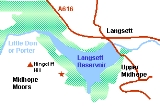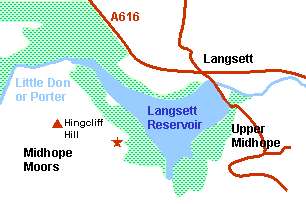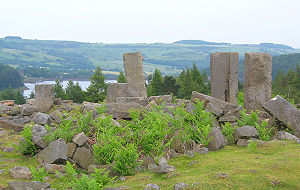
Langsett Reservoir
Encyclopedia


Yorkshire
Yorkshire is a historic county of northern England and the largest in the United Kingdom. Because of its great size in comparison to other English counties, functions have been increasingly undertaken over time by its subdivisions, which have also been subject to periodic reform...
, England
England
England is a country that is part of the United Kingdom. It shares land borders with Scotland to the north and Wales to the west; the Irish Sea is to the north west, the Celtic Sea to the south west, with the North Sea to the east and the English Channel to the south separating it from continental...
, near the villages of Langsett
Langsett
Langsett is a village and civil parish near Penistone in South Yorkshire. It lies near the southern edge of the Metropolitan Borough of Barnsley and on the edge of the Peak District National Park. At the 2001 census it had a population of 161....
and Upper Midhope, on the edge of the Peak District National Park
Peak District
The Peak District is an upland area in central and northern England, lying mainly in northern Derbyshire, but also covering parts of Cheshire, Greater Manchester, Staffordshire, and South and West Yorkshire....
. The reservoir was constructed between 1898 and 1904, and is now managed by Yorkshire Water
Yorkshire Water
Yorkshire Water is a water supply and treatment utility company servicing West Yorkshire, South Yorkshire, the East Riding of Yorkshire, part of North Lincolnshire, most of North Yorkshire and part of Derbyshire, in England. The company has its origins in the Yorkshire Water Authority, one of ten...
. Fed by the Little Don
Little Don River
The Little Don River also known as The Porter, is a tributary of the River Don in England. Arising on the Langsett Moors in the northern Peak District, the Little Don River feeds the Langsett and Underbank Reservoirs...
or Porter River, it is around a mile long, and supplies water for Sheffield
Sheffield
Sheffield is a city and metropolitan borough of South Yorkshire, England. Its name derives from the River Sheaf, which runs through the city. Historically a part of the West Riding of Yorkshire, and with some of its southern suburbs annexed from Derbyshire, the city has grown from its largely...
and Barnsley
Barnsley
Barnsley is a town in South Yorkshire, England. It lies on the River Dearne, north of the city of Sheffield, south of Leeds and west of Doncaster. Barnsley is surrounded by several smaller settlements which together form the Metropolitan Borough of Barnsley, of which Barnsley is the largest and...
via the Langsett Treatment Works.
Construction and statistics
Construction of the reservoir began in 1898, the logistics of getting the workforce and materials to Langsett caused great difficulty as most of them came up from Sheffield. This involved a journey over four different stretches of railway line, the first leg was from Sheffield Midland Station to Deepcar, this was followed by a journey to StocksbridgeStocksbridge
Stocksbridge is a small town and civil parish in the City of Sheffield, in South Yorkshire, England, with a population of 13,663. It lies just to the east of the Peak District....
on the Samuel Fox and Company
Samuel Fox and Company
Samuel Fox and Company or "Fox's" is the commonly used name for the major steel complex built in the Upper Don Valley at Stocksbridge, near Sheffield, South Yorkshire, England.- History :...
private line. From the Samuel Fox steelworks a new one mile long line was built to reach the Underbank Reservoir to join up with the Water Authority track up to Langsett Reservoir.
The reservoir is 125 acres (51 hectares) in area with a depth of 97 feet and has a holding capacity of 1,408 million gallons, making it the largest of the water supply reservoirs in the immediate Sheffield district. The catchment area is the Langsett Moors to the west and this covers an area of 5,203 acres (2105 hectares). The embankment is 1156 feet (352 metres) long with a height of 117 feet (35 metres) from the bottom of the old river bed. The embankment is 720 feet (219 metres) wide at the bottom tapering to 36 feet (11 metres) at the top and contains 900,000 cubic yards of infill in the puddle
Puddling (engineering)
Puddle is a watertight material based on clay used in building and maintaining canals or reservoirs. Puddling is the process of lining the channel with puddle....
wall and concrete trench, making it one of the largest earth embankments in Great Britain.
The minor road (Midhope Cliff Lane) which runs across the embankment is thought to be the longest single carriageway of any reservoir in Great Britain. The embankment road has a sharp bend in it as it joins the A616 main road, this was a last minute change in construction plans, as keeping it straight would have meant the demolition of the Waggon and Horses public house
Public house
A public house, informally known as a pub, is a drinking establishment fundamental to the culture of Britain, Ireland, Australia and New Zealand. There are approximately 53,500 public houses in the United Kingdom. This number has been declining every year, so that nearly half of the smaller...
. The reservoir was completed in 1904 when Alderman T.R. Gainsford closed the valve in the Langsett tower and the reservoir started to fill up, he was then presented with a golden key by the engineer William Watts.
Local depopulation was used in the early part of the twentieth century to improve the water purity, and six farms were abandoned these included Brookhouse farm and North America farm, the last farmer left around 1907. The ruins of North America remain to the south-west of the reservoir even though it was used for target practice during World War II
World War II
World War II, or the Second World War , was a global conflict lasting from 1939 to 1945, involving most of the world's nations—including all of the great powers—eventually forming two opposing military alliances: the Allies and the Axis...
. In 1962 conifers were planted around the reservoir as shown on the map, with the aim of providing a habitat for many species of indigenous wildlife. This plantation is called Langsett Woods. In recent years the woods have been restructured with most of the coniferous trees being felled and being replaced by oak
Oak
An oak is a tree or shrub in the genus Quercus , of which about 600 species exist. "Oak" may also appear in the names of species in related genera, notably Lithocarpus...
and birch
Birch
Birch is a tree or shrub of the genus Betula , in the family Betulaceae, closely related to the beech/oak family, Fagaceae. The Betula genus contains 30–60 known taxa...
trees in an effort to created a new upland oak woodland. In 2007 a pond was created near Brookhouse Bridge at the western end of the reservoir to help dragonflies
Dragonfly
A dragonfly is a winged insect belonging to the order Odonata, the suborder Epiprocta or, in the strict sense, the infraorder Anisoptera . It is characterized by large multifaceted eyes, two pairs of strong transparent wings, and an elongated body...
, frog
Frog
Frogs are amphibians in the order Anura , formerly referred to as Salientia . Most frogs are characterized by a short body, webbed digits , protruding eyes and the absence of a tail...
s, newt
Newt
A newt is an aquatic amphibian of the family Salamandridae, although not all aquatic salamanders are considered newts. Newts are classified in the subfamily Pleurodelinae of the family Salamandridae, and are found in North America, Europe and Asia...
s and toad
Toad
A toad is any of a number of species of amphibians in the order Anura characterized by dry, leathery skin , short legs, and snoat-like parotoid glands...
s establish new colonies. The Pennine peaks of Pike Lowe (478 m) and Hingcliff Common (358 m) lie to the south and south-west of the reservoir, respectively. The area is used for sheep farming and grouse
Grouse
Grouse are a group of birds from the order Galliformes. They are sometimes considered a family Tetraonidae, though the American Ornithologists' Union and many others include grouse as a subfamily Tetraoninae in the family Phasianidae...
shooting, and it is popular with walkers, mountain bikers
Mountain biking
Mountain biking is a sport which consists of riding bicycles off-road, often over rough terrain, using specially adapted mountain bikes. Mountain bikes share similarities with other bikes, but incorporate features designed to enhance durability and performance in rough terrain.Mountain biking can...
and bird watchers
Birdwatching
Birdwatching or birding is the observation of birds as a recreational activity. It can be done with the naked eye, through a visual enhancement device like binoculars and telescopes, or by listening for bird sounds. Birding often involves a significant auditory component, as many bird species are...
with treecreeper
Treecreeper
The treecreepers are a family, Certhiidae, of small passerine birds, widespread in wooded regions of the Northern Hemisphere and sub-Saharan Africa. The family contains ten species in two genera, Certhia and Salpornis...
s, woodpecker
Woodpecker
Woodpeckers are near passerine birds of the order Piciformes. They are one subfamily in the family Picidae, which also includes the piculets and wrynecks. They are found worldwide and include about 180 species....
s and owl
Owl
Owls are a group of birds that belong to the order Strigiformes, constituting 200 bird of prey species. Most are solitary and nocturnal, with some exceptions . Owls hunt mostly small mammals, insects, and other birds, although a few species specialize in hunting fish...
s to be seen in the vicinity.
Langsett water treatment works
The present day Langsett water treatment works were built to replace the older works at Midhope and Langsett reservoirs. The older works used sand filter bedsSlow sand filter
Slow sand filters are used in water purification for treating raw water to produce a potable product. They are typically 1 to 2 metres deep, can be rectangular or cylindrical in cross section and are used primarily to treat surface water...
to treat the water, although the water was safe to drink, the sand filters had never been able to removed the brown colouration caused by rainwater falling on the surrounding peat moorland. After much complaining from consumers, it was decided in 1980 to build a completely new treatment works. South Yorkshire Water Authority gave permission in December 1981 to build the works in an old quarry adjacent to the reservoir wall. Worked started in 1983 with water from the new works going into the supply system in July 1986. The works clarify the water by the addition of chemicals before the filtration stage to bring it up to the latest EU standards
Water supply and sanitation in the European Union
Water Supply and Sanitation in the European Union still is under the responsibility of each member state. Nevertheless, the European Union established some policies which impact the National water strategies tremendously. However, WSS evolved in every Member State independently until the policies...
. The works can produce 60,000 cubic metres (60 million litres) of water per day.

